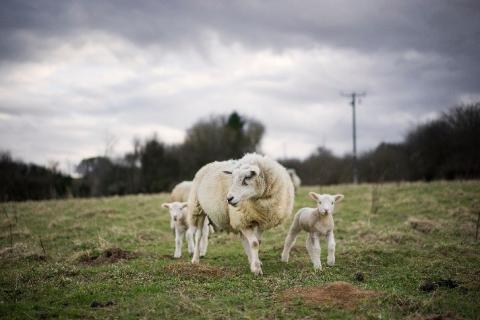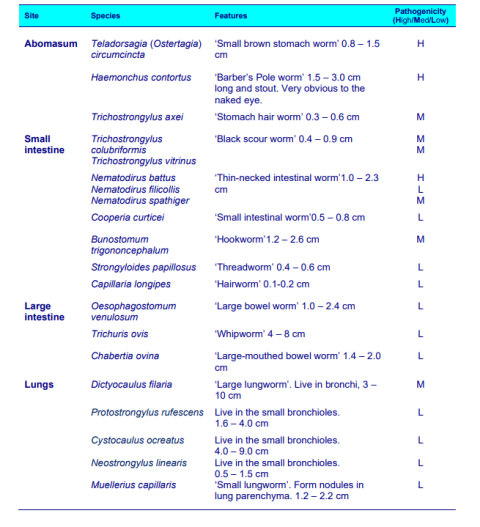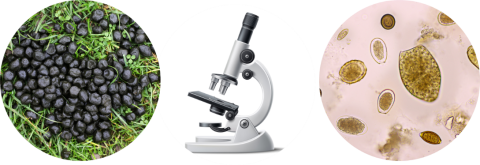Dr Natalie Meades: IBERS, Aberystwyth University.
December 2023
- Gastrointestinal nematodes (GIN) can have damaging effects on animal performance, health and welfare and are estimated to cost the UK sheep sector a considerable amount of money each year from loss of production and the cost of treatment.
- Treatment for infections is predominantly associated with the use of chemical based anthelmintics. However, since their role out, anthelmintic use has been extensive and has led to cases of anthelmintic resistance in animals. As such, there is need to implement sustainable strategies on farm to control and reduce infections. Such strategies include alterations in management systems, the careful use of anthelmintics and genetics.
- Resistance and resilience to GIN infections has been demonstrated to vary between breeds and between individuals within a flock. Where some individuals are naturally more resistant to GIN than others, that is they have good immune responses to infections. Similarly, others are more resilient to GIN where they can withstand high parasitic burdens without detriment to health or production. Part of this variation is owed to genetics. Therefore, there is great interest in selecting individuals within breeding programmes for GIN resistance or resilience.
- As with any trait selected for in breeding programmes, it is important that any potential trade-offs are considered. For example, disease resistance or resilience at the expense of economically important traits. As such, research in this area is ongoing and continuing to be developed.
Introduction
Helminths are parasitic worms which include cestodes (tape worms), trematodes (flat worms) and nematodes (roundworms). In Europe the helminths of greatest economic importance for grazing ruminants are, gastrointestinal nematodes (Ostertagia ostertagi, Cooperia oncophora, Teladorsagia circumcincta, Haemonchus contortus and Trichostrongylus spp.), common liver fluke (Fasciola hepatica) and bovine lungworm (Dictyocaulus viviparus). Animals infected with helminths often display poor feed intakes, growth rates, carcass weights, carcass compositions, wool growth, milk yields and fertility, as such leading to poor performance as well as compromising health and welfare. Moreover, this results in financial losses and inefficiencies within systems. To put this into perspective, a study estimated the financial cost of helminth infections in ruminants across 18 countries to be €1.8 billion per year, with 81% of this cost attributed to loss of production and the remaining 19% attributed to treatment.
Treatment and control of helminth infections are predominantly associated with the use of chemical based anthelmintics. However, since their role out, anthelmintic use has been extensive and included high dosing frequencies, repetitive use of the same drug class and over/ under dosing in relation to live weight. As such, this has led to an increasing number of cases of anthelmintic resistance in animals. Moreover, the effects of climate change such as warmer global temperatures and increased rainfall are predicted to create environments more conducive for the survival, growth and prevalence of certain parasites, thereby adding to the problem. As such sustainable strategies are needed to reduce and control infections within livestock production systems.
Certain animals demonstrate natural resistance or resilience to infection. Therefore, one point of focus is to selectively breed for resistant or resilient sheep. The definitions of resistance and resilience are outlined below as described by SCOPS.
Gastrointestinal Nematodes
In the UK there are approximately 20 different species of gastrointestinal nematodes (GIN) that have been identified to affect sheep (Figure. 1). Moreover, it is estimated that the financial cost of GIN infections within the UK sheep sector is approximately £84 million per year. As such there is great interest in selectively breeding sheep for either resistance or resilience to GIN infections.
Figure 1: Nematode parasites which effect sheep in the UK (SCOPS, 2022)
Resistance to Gastrointestinal Nematodes
It has been demonstrated that resistance to GIN infections can vary between certain breeds of sheep as well as between individuals within a flock. A study conducted in a group of female Scottish Blackface ewe lambs from the same flock, treated in exactly the same way, showed variation in the number of individuals that showed susceptibility and resistance to parasitic burdens. Variation in resistance to GIN infections can be influenced by a variety of factors such as, age (maturity), previous exposure to GIN, nutritional status, physiological status and genetics. Therefore, there is great interest associated with the selective breeding of individuals for resistance to GIN within breeding programmes.
Sheep that demonstrate resistance to GIN have been identified to have good immune responses to parasitic infections. It is suggested that sheep resistant to GIN are able to prevent or reduce the likelihood of parasitic infections occurring by preventing infective larvae from establishing or by rejecting larvae that have implanted within the GI tract. Moreover, studies have demonstrated immune response to infection to supress nematode growth and development, where certain adult parasitic worms present in the GI tracts of resistant sheep have been observed to be smaller in length and have poor fecundities (number of eggs present in-utero) in comparison to worms present in susceptible sheep.
When considering selecting individuals for certain traits within breeding programmes it is important to consider what animals to include. In the past a large proportion of breeding programmes have focussed on the sire due to the ability of one male to pass genetics onto many offspring. Whilst this is important, it is just as important to not overlook the ewe. In the case of GIN, studies have suggested attention is needed on the ewe during the peri-parturient stage of gestation. Where studies have demonstrated peri-parturient ewes, approximately two weeks prior to lambing until 6 weeks post lambing to have reduced host immunity to GIN infections and therefore carry more adult nematodes and shed eggs within their faeces. This is thought to be associate with changes to metabolism and/ or nutritional stress which compromises immunity. As such, this period known as the periparturient rise creates more opportunity for pasture contamination and therefore exposes susceptible animals such as young growing lambs to infections. Another point to consider with regards to breeding is if there are any potential trade-offs with breeding for GIN resistance. For example, enhanced immunity at the expense of economically important traits such as growth, milk output, reproduction and the ability to resist other pathogens and parasites within the environment.
How is Resistance Being Measured?
To determine the degree of resistance an individual has to parasitic infection various measures are used which are typically based on phenotypic traits. The most commonly used measure is faecal egg counts (FEC), which are relatively easy to do and act as a proxy for worm burden. Individuals that have low faecal egg counts are regarded as having good resistance to GIN. An example of this includes Signet Breeding Services a division of the agricultural and horticultural development board (AHDB) which uses the FEC of lambs from approximately 21 weeks of age as a proxy for worm resistance to generate FEC estimated breeding values (EBV) from.
The use of FEC as a proxy for GIN resistance has been demonstrated to show good success. A study demonstrated the FEC of ewe lambs at 21 days of age to be a good predicter of the total faecal egg output of ewes in their first lambing and lactation. Moreover, it has been demonstrated that the FEC trait has a low-moderate heritability. Where the heritability of a trait is measured on a scale of 0 – 1 and can be defined by how much variation between animals is due to genetic factors. However, a review study suggests that more objective and reliable indices are needed regarding the limitations of using FEC, some of which include the variable relationship between FEC and total worm burdens and performing FEC without risking pathogenic effects to animals.
An alternative way of determining an animal’s resistance to GIN infection is through the measurement of antibodies known as immunoglobulins (Ig) which are produced in response to infection. Two particular Ig of interest are IgA and IgE (Figure 2). IgA has been demonstrated to affect fourth stage larvae (L4) and therefore affect the growth of GIN. A study demonstrated salivary IgA to be a good biomarker for GIN resistance in sheep against the carbohydrate larval surface antigen (CarLA) present on infective third stage larvae (L3). Likewise, a study investigated the use of salivary IgA as a biomarker for resistance to Teladorsagia circumcincta L3 in Lleyn sheep. The results of the study indicated salivary IgA to be a suitable biomarker and to have twice the heritability in comparison to FEC. IgE has been demonstrated to affect third stage larvae (L3) and therefore affect the larval establishment. A study in Scottish Blackface lambs grazing contaminated pasture demonstrated lambs with low FEC and therefore regarded as being resistant to infection to have higher concentrations of IgE circulating in the blood in comparison to lambs with high FEC.
Figure 2: The typical life cycle of a gastrointestinal nematode and the potential role of immunoglobulins in resistance to infection as described by Aboshady, et al. (2020).
Research has also investigated genetic markers for resistance to GIN infection with the hope of improving the efficiency of breeding programmes. Studies have identified genes within the polymorphic major histocompatibility complex (Ovar-MHC) on chromosome 20 and the interferon ɣ gene on Ovis aries chromosome 3 to be associated with resistance to certain GIN. Therefore, the use of genetic markers could potentially be used as biomarkers for GIN resistance in the future.
Resilience to Gastrointestinal Nematodes
Sheep with resilience to GIN can be described as individuals that do not display poor performance or health attributes despite having high parasitic burdens and can therefore withstand parasitic damage to the GI tract. There are mixed reviews in the literature with regards to the effectiveness of breeding for this trait. A study suggested that the selection of animals resilient to GIN infections to be controversial based on the premise that these animals would have high FEC and as such contaminate pastures, which could be problematic for susceptible animals within a flock such as young lambs or peri-parturient ewes. Moreover, should animals become immunosuppressed by developing other pathologies or receive inadequate nutrition, this may make them more susceptible to the damaging effects of parasitic infection. Likewise, should individuals move from one holding to another there is question as to resilience taking effect in new environments.
Summary
Gastrointestinal nematode infections can have detrimental effects on animal health, welfare, performance and farm economics. Traditionally anthelmintics have been used to treat infections, however their use has been extensive and not sustainable. This has contributed to anthelmintic resistance in animals. As such there is need to find alternative strategies to prevent and control infections. Certain breeds and individuals within a flock demonstrate resistance or resilience to GIN infections, part of this is associated with genetics. As such, there is great interest associated with selectively breeding individuals for resistance or resilience to GIN within breeding programmes. However, it is important as with any trait selected for that there are no potential trade-offs associated with economically important traits, as such research associated with this is ongoing and continuing to be developed.



